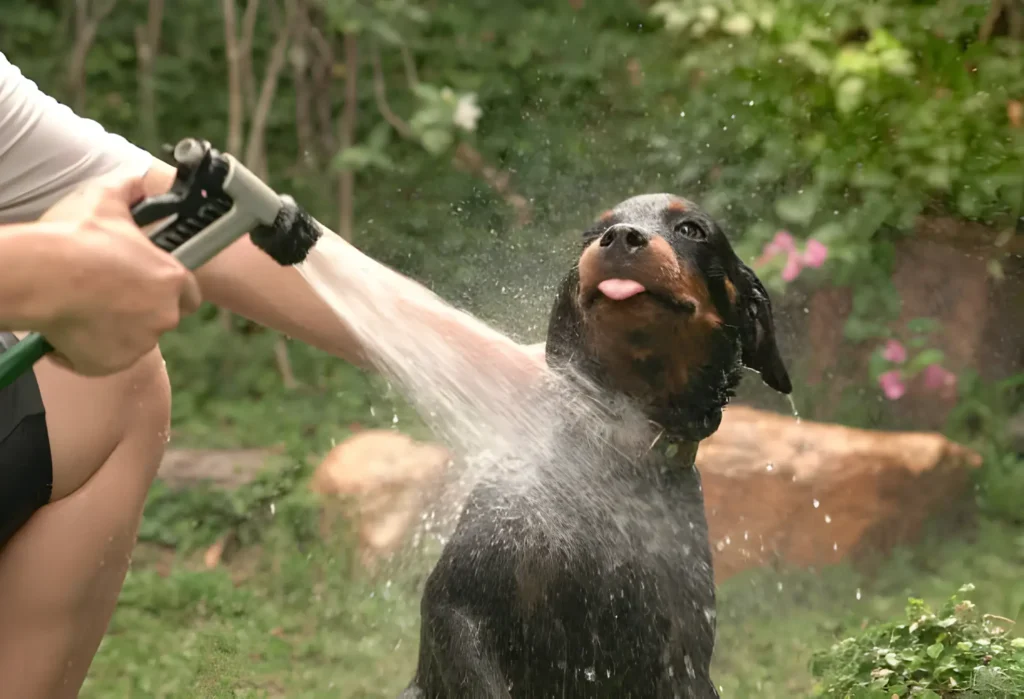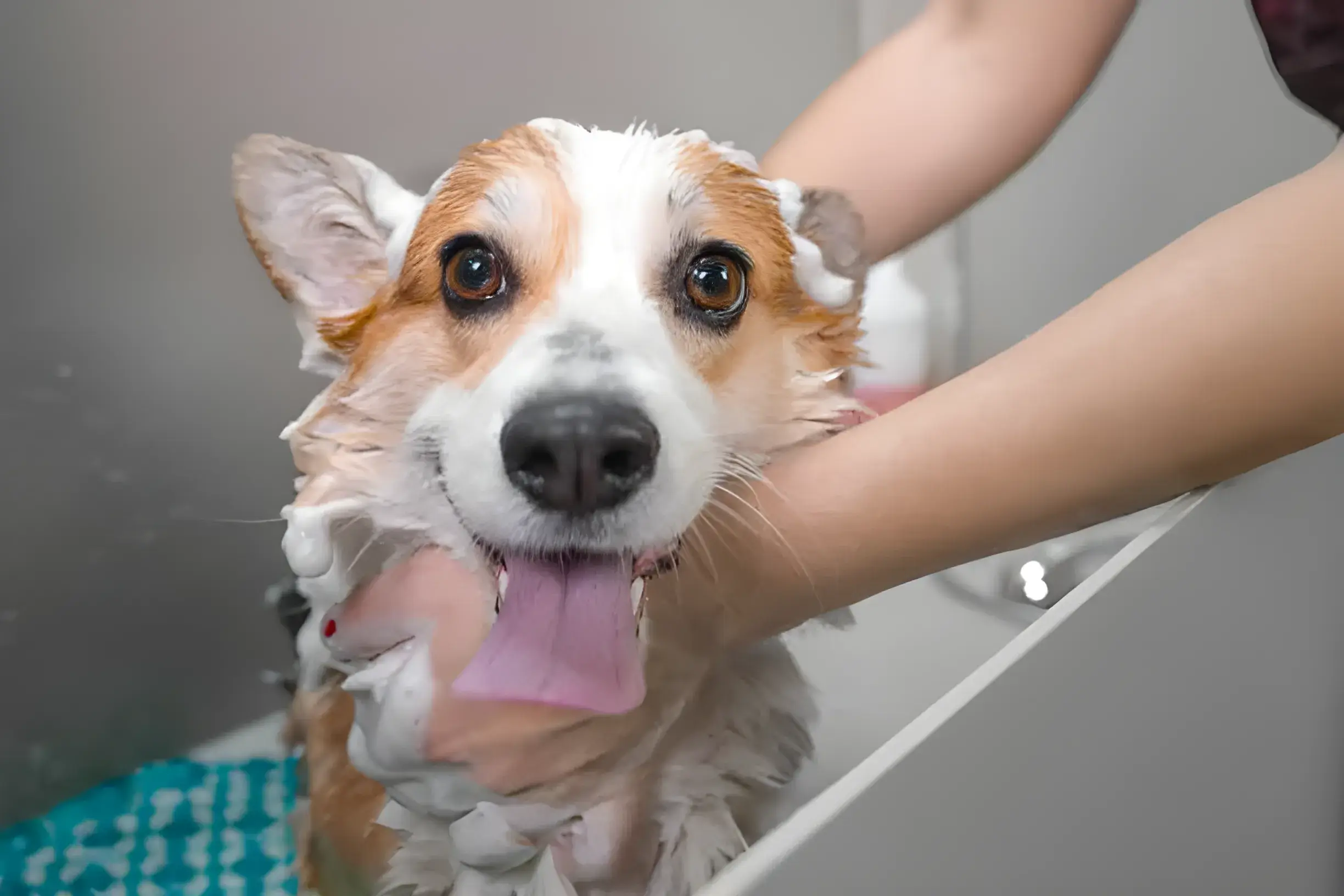The short answer is: it depends. Most healthy dogs don’t need a bath more than once a month. Twice-weekly baths might be necessary for dogs with specific coat types, those who love getting messy, or pups with skin issues that require frequent medicated washes.
Let’s break down exactly when twice-a-week baths are a good idea, and when it could harm your furry friend’s health.
Factors Affecting Your Dog’s Bathing Schedule
Coat Type:
- Oily Coats: Breeds like Basset Hounds, Cocker Spaniels, and Retrievers need more frequent baths (up to twice weekly) to prevent greasy buildup and odor.
- Double Coats: Huskies, German Shepherds, etc., should be bathed less frequently, especially during shedding seasons.
- Short, Smooth Coats: Chihuahuas, Boxers, and similar dogs generally only need bathing every 2-3 months.
Activity Level: Does your dog spend most of their time indoors, or are they a mud-loving adventurer? Active dogs who get dirty frequently benefit from more baths.
Skin Conditions: Dogs with allergies, infections, or seborrhea often have specific bathing schedules recommended by their veterinarian. This could be more or less frequent than usual.
Age: Puppies and senior dogs may have more sensitive skin. Consult your vet about the appropriate bathing frequency for them.
Why Bathing Too Often Can Be Bad
Dogs have a delicate balance of natural oils and beneficial bacteria on their skin. These oils protect their coat, keep their skin supple, and act as a first line of defense against irritation. Over-bathing disrupts this balance, leading to:
Dry, Itchy Skin: Without enough natural oils, your dog’s skin can become flaky, red, and uncomfortable. They might scratch incessantly, further worsening the problem.
Increased Vulnerability to Infections: Healthy skin has a natural barrier against bacteria and fungi. Excessive bathing weakens this barrier, making your pup more prone to skin infections that can be painful and require vet treatment.
Dull, Brittle Coat: Those natural oils give your dog’s fur a healthy shine. Stripped away, the coat becomes dry, lacks luster, and may even start to break or shed more easily.
Signs Your Dog Needs a Bath

Aside from the obvious (think a joyful roll in a mud puddle!), here are some tell-tale signs it’s bath time:
Noticeable Odor: All dogs have a bit of a natural “doggy” smell. But if the odor is strong and unpleasant, it’s usually a sign of built-up dirt, oils, or possibly even a developing skin issue.
Greasy or Matted Fur: If your dog has a medium or long coat or an especially oily coat, their fur might become visibly greasy or clump together in mats without regular baths.
Excessive Scratching: While some scratching is normal, if your dog is constantly focused on scratching or licking themselves, it could point to irritated skin in need of a cleansing bath.
The Nose Knows: Signs Your Dog Needs a Bath
Sometimes, a simple sniff test tells you all you need to know! Look out for:
“Wet Dog” Smell: Even when dry, a dog needing a bath often retains a musty, stale odor that’s hard to miss.
“Frito Feet”: If their paws have a distinct yeasty, corn chip-like smell, bacteria is likely building up, and a bath is in order.
Greasy Back: Run your hand along your dog’s back. If it feels oily or leaves a residue, it’s time for them to hop in the tub.
Bathing Best Practices: Do’s and Don’ts
Do: Use lukewarm water. Too hot or too cold will make your dog uncomfortable. Stick to specialty dog shampoo designed for their specific needs.
Do: Rinse thoroughly. Leftover shampoo residue is a major irritant, so rinse until the water runs completely clear.
Do: Use praise and treats. A positive association makes future baths easier!
Don’t: Use human shampoo. It has the wrong pH for dogs, causing dryness and potentially throwing off their skin balance.
Don’t: Wash their face directly. Use a damp washcloth for their face to avoid getting soap in their eyes.
Breed-Specific Bathing Chart
| Breed | Coat Type | Ideal Bathing Frequency | Notes |
|---|---|---|---|
| Labrador Retriever | Oily | Every 4-6 weeks | Prone to skin issues, use gentle shampoo |
| Golden Retriever | Oily | Every 4-6 weeks | Similar coat needs to Labradors |
| Beagle | Short, Smooth | Every 2-3 months | Unless they get exceptionally dirty |
| German Shepherd | Double Coat | Every 3-4 months | Avoid baths during shedding season |
| Poodle | Curly | Every 3-4 weeks | Matting is a concern |
| Yorkshire Terrier | Long, Silky | Every 2-3 weeks | Prone to tangles |
| Dachshund | Short, Smooth or Long | Every 2-3 months | Long-haired Dachshunds may need more frequent baths |
| Boxer | Short, Smooth | Every 2-3 months | Low maintenance coat |
| Chihuahua | Short, Smooth | Every 3-4 months | Sensitive skin, bathe only when necessary |
| Bulldog | Short, Wrinkled | Every 4-6 weeks | Clean wrinkles to prevent infections |
| Cocker Spaniel | Oily, Long | Every 4-6 weeks | Coat needs regular grooming |
| Basset Hound | Oily, Short | Every 4-6 weeks | Very oily coat, prone to odor |
| Maltese | Long, Silky | Every 2-3 weeks | Requires frequent brushing |
| Shih Tzu | Long, Silky | Every 3 weeks | Prone to matting |
Product Recommendations
Deodorizing: Ideal for active dogs, or breeds with naturally oily coats, who need a bit of extra odor-fighting power.
Oatmeal-based: Formulated with soothing ingredients to calm itchy or inflamed skin during and after bath time.
Hypoallergenic: A must for dogs with sensitivities. Look for gentle, fragrance-free shampoos to avoid irritation.
Puppy Shampoo: Extra mild cleansers made specifically for young dogs so you can start a good bathing routine early.
Ask the Vet
My pup seems sensitive; can I still use baby shampoo on them?
Vet Answer: No, even gentle baby shampoo isn’t formulated for a dog’s skin. Using it can lead to dryness and irritation. It’s best to always choose dog-specific shampoos.
My dog gets dandruff easily. Does that mean they need more baths?
Vet Answer: Not necessarily. The cause of the dandruff matters. It’s important to see your vet for a diagnosis so we can recommend the best bathing routine and any medications your pup might need.
Conclusion
The best bathing schedule keeps your dog comfortable and healthy. For most dogs, this means a bath once every 1-3 months, but some exceptions apply. When in doubt, a quick chat with your vet can bring peace of mind.
The photo featured below the post headline is Credit: Ирина Мещерякова/istockphoto
I hope you find this post helpful and informative. If Yes’ feel free to share it with your friends!
Frequently Asked Question
My dog hates baths. Help!
Start slowly. Treats, toys, and a gentle touch make baths less scary. Consider non-slip mats for the tub and praise-filled bath sessions.
Can I use dry shampoo for dogs?
Dry shampoo is useful between baths but shouldn’t fully replace them. It’s best for occasional touch-ups or dogs who strongly resist water.
Is it okay to bathe my dog if they have a skin infection?
Consult your vet. They may recommend a medicated shampoo and a specific bathing routine to manage the infection effectively.
Is it OK to bathe a puppy once a week?
Puppies generally need less frequent bathing than adult dogs. Too many baths can dry out their sensitive skin. Consult your vet for a breed-specific puppy bathing schedule.
What happens if I bathe my dog every day?
Daily bathing strips essential oils, leaving your dog’s skin dry, irritated, and prone to infections. Stick to recommended bathing schedules unless directed otherwise by your vet.
How often should I bathe my dog in winter?
Baths can be even less frequent in winter, as there’s less mud and outdoor mess. Focus on paw cleaning after walks and brush their fur regularly.
How do I know if my dog’s shampoo is too harsh?
Signs include itchy skin, redness, excessive shedding, or a dull coat. Switch to a gentle, hypoallergenic dog shampoo formulated for sensitive skin.
Can I bathe my dog after they get spayed or neutered?
Wait until your vet gives the okay. Bathing can irritate incision sites. Discuss post-surgical care instructions thoroughly with your vet.
How often should I bathe my dog with fleas?
A flea bath can kill fleas on contact. However, follow vet instructions for comprehensive flea treatment and prevention, which often involves medication in addition to bathing.
My dog gets dirty paws on walks. Should I give them full baths?
Consider paw-washing stations or using dog booties. Frequent full baths for dirty paws alone can be excessive.
Are there natural alternatives to dog shampoo?
While some DIY solutions exist, it’s safest to stick with dog-formulated shampoos for their balanced pH and safe ingredients. Consult your vet if your dog is particularly sensitive.

